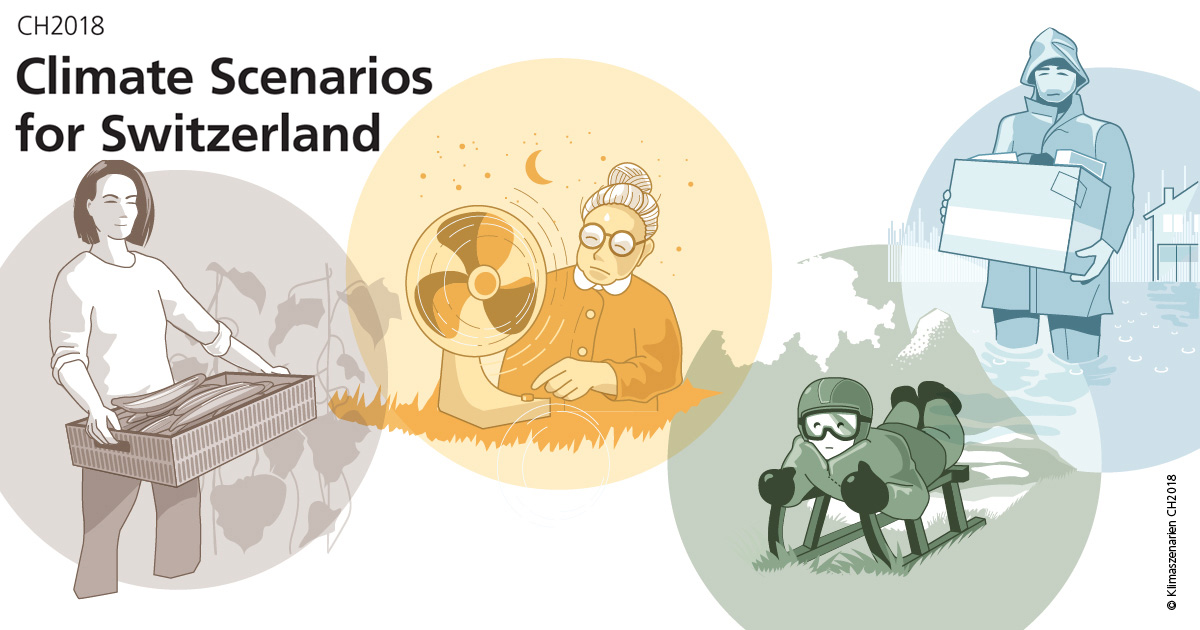The climate in Switzerland is changing. In order to provide decision-makers with the best possible basis for making their decisions, Switzerland needs updated and reliable climate scenarios. Based on the latest climate models ,results from user surveys, and in close collaboration with the scientific community, new climate change scenarios are developed as part of CH2018.
In the meantime, the new Swiss climate scenarios have been published as part of the Climate CH2025 project. They expand on the previous results with longer measurement series and information from new, high-resolution climate models. The qualitative statements remain unchanged from the CH2018 climate scenarios, but the quantitative estimates have changed. It is recommended that the results of Climate CH2025 be used.

The new reference for adaptation shows where and how climate change will affect Switzerland. The Climate Scenarios combine simulations that use the latest climate models with observations of the trends thus far, providing the most accurate picture to date of our country’s future climate. This makes it possible to make firm projections on the different aspects of climate change. The CH2018 scenarios will replace the Swiss climate scenarios dating from 2011 (CH2011).
Objectives
Climate Scenarios and further climate services serve as the basis for decision making in mitigation and adaptation to climate change. Since 2014, it has been an official mandate of the federal government to produce regular climate scenarios that will provide decision-makers with the most up-to-date knowledge foundation for planning adaptive measures to climate change.
Content
CH2018 – the new generation of Swiss climate scenarios – provides several innovations:
- Another seven years’ worth of data have been collected since the previous report.
- The latest scientific findings have also informed the CH2018 Scenarios. The new simulations have four times the spatial resolution of the simulations used in 2011 for the last report.
- The statistical methods have been refined in order to facilitate improvements in localisation.
- The current Climate Scenarios provide more concrete information on a range of key areas, including extreme events and local climate indicators.
Highlights - key messages
- Dry summers
In the long term, average amounts of precipitation in the summer months will shrink, and evaporation will increase. The ground will become drier, there will be fewer rainy days and the longest precipitation-free period will last longer. - Heavy Precipitation
Heavy precipitation events are likely to become significantly more frequent and intense in the future compared to today. This is the case for all seasons, but particularly for winter. Rare extreme events such as 100-year precipitation events will be markedly more intense. - More hot days
The increases in the highest temperatures are even more pronounced than for the average temperatures. Heatwaves and hot days and nights become more frequent and extreme. Heat stress is greatest in low-lying urban areas with high population densities. - Snow-scarce winters
Winters will be significantly warmer by the middle of the century as well. Although there will be more precipitation, it will fall more frequently in the form of rain because of the higher temperatures. Particularly in lower-lying regions, it will snow less often and in smaller quantities. The snowy areas of Switzerland will therefore shrink considerably.
- When climate change mitigation takes hold
Lowering the emissions of greenhouse gases globally could effectively stem climate change. Approximately half of the potential changes in Switzerland’s climate could be avoided by the middle of the 21st century, two-thirds by the end of the century. Although temperatures will still rise in Switzerland, the increases will be much smaller than if emissions are allowed to increase unchecked.
Main project partners
- Federal Office of Meteorology and Climatology MeteoSwiss
- ETH Zurich
- Center for Climate Systems Modeling (C2SM)
Project co-partners
- University of Bern
- ProClim | SCNAT
Last modification 04.11.2025
Contact
Federal office of meteorology and climatology MeteoSwiss
Operation Center 1
P.O. Box
CH-8058 Zurich-Airport





